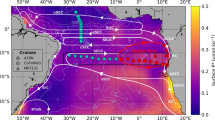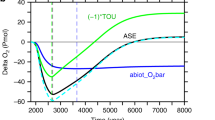Abstract
Oceanic fixed-nitrogen concentrations are controlled by the balance between nitrogen fixation and denitrification1,2,3,4. A number of factors, including iron limitation5,6,7, can restrict nitrogen fixation, introducing the potential for decoupling of nitrogen inputs and losses2,5,8. Such decoupling could significantly affect the oceanic fixed-nitrogen inventory and consequently the biological component of ocean carbon storage and hence air–sea partitioning of carbon dioxide2,5,8,9. However, the extent to which nutrients limit nitrogen fixation in the global ocean is uncertain. Here, we examined rates of nitrogen fixation and nutrient concentrations in the surface waters of the Atlantic Ocean along a north–south 10,000 km transect during October and November 2005. We show that rates of nitrogen fixation were markedly higher in the North Atlantic compared with the South Atlantic Ocean. Across the two basins, nitrogen fixation was positively correlated with dissolved iron and negatively correlated with dissolved phosphorus concentrations. We conclude that inter-basin differences in nitrogen fixation are controlled by iron supply rather than phosphorus availability. Analysis of the nutrient content of deep waters suggests that the fixed nitrogen enters North Atlantic Deep Water. Our study thus supports the suggestion that iron significantly influences nitrogen fixation5, and that subsequent interactions with ocean circulation patterns contribute to the decoupling of nitrogen fixation and loss2,4,8.
This is a preview of subscription content, access via your institution
Access options
Subscribe to this journal
Receive 12 print issues and online access
$259.00 per year
only $21.58 per issue
Buy this article
- Purchase on Springer Link
- Instant access to full article PDF
Prices may be subject to local taxes which are calculated during checkout



Similar content being viewed by others
References
Redfield, A. C. The biological control of chemical factors in the environment. Am. Sci. 46, 205–221 (1958).
Codispoti, L. A. in Productivity of the Ocean: Present and Past (eds Berger, W., Smetacek, V. & Wafer, G.) 377–394 (Wiley, 1989).
Tyrrell, T. The relative influences of nitrogen and phosphorus on oceanic primary production. Nature 400, 525–531 (1999).
Deutsch, C., Sarmiento, J. L., Sigman, D. M., Gruber, N. & Dunne, J. P. Spatial coupling of nitrogen inputs and losses in the ocean. Nature 445, 163–167 (2007).
Falkowski, P. G. Evolution of the nitrogen cycle and its influence on the biological sequestration of CO2 in the ocean. Nature 387, 272–275 (1997).
Mills, M. M., Ridame, C., Davey, M., La Roche, J. & Geider, R. J. Iron and phosphorus co-limit nitrogen fixation in the eastern tropical North Atlantic. Nature 429, 292–294 (2004).
Berman-Frank, I., Quigg, A., Finkel, Z. V., Irwin, A. J. & Haramaty, L. Nitrogen-fixation strategies and Fe requirements in cyanobacteria. Limnol. Oceanogr. 52, 2260–2269 (2007).
Moore, J. K. & Doney, S. C. Iron availability limits the ocean nitrogen inventory stabilizing feedbacks between marine denitrification and nitrogen fixation. Glob. Biogeochem. Cycles 21, GB20001 (2007).
Broecker, W. S. & Henderson, G. M. The sequence of events surrounding Termination II and their implications for the cause of glacial-interglacial CO2 changes. Paleoceanography 13, 352–364 (1998).
Li, Y. H. & Peng, T. H. Latitudinal change of remineralization ratios in the oceans and its implication for nutrient cycles. Glob. Biogeochem. Cycles 16, 1130 (2002).
Gruber, N. & Sarmiento, J. L. Global patterns of marine nitrogen fixation and denitrification. Glob. Biogeochem. Cycles 11, 235–266 (1997).
Wu, J., Sunda, W., Boyle, E. A. & Karl, D. M. Phosphate depletion in the Western North Atlantic Ocean. Science 289, 759–762 (2000).
Hood, R. R., Coles, V. J. & Capone, D. G. Modeling the distribution of Trichodesmium and nitrogen fixation in the Atlantic Ocean. J. Geophys. Res. 109, CO6006 (2004).
Capone, D. G. et al. Nitrogen fixation by Trichodesmium spp.: An important source of new nitrogen to the tropical and subtropical North Atlantic Ocean. Glob. Biogeochem. Cycles 19, GB2024 (2005).
Galbraith, E. D., Kienast, M., Pedersen, T. F. & Calvert, S. E. Glacial–interglacial modulation of the marine nitrogen cycle by high-latitude O2 supply to the global thermocline. Paleoceanography 19, PA4007 (2004).
Mahaffey, C. et al. Biogeochemical signatures of nitrogen fixation in the eastern North Atlantic. Geophys. Res. Lett. 30, 1300 (2003).
Tyrrell, T. et al. Large-scale latitudinal distribution of Trichodesmium spp. in the Atlantic Ocean. J. Plankton Res. 25, 405–416 (2003).
Voss, M., Croot, P., Lochte, K., Mills, M. M. & Peeken, I. Patterns of nitrogen fixation along 10∘ N in the tropical North Atlantic. Geophys. Res. Lett. 31, L23S09 (2004).
Sohm, J. A. & Capone, D. G. Phosphorus dynamics of the tropical and subtropical North Atlantic: Trichodesmium spp. versus bulk plankton. Mar. Ecol. Progr. Ser. 317, 21–28 (2006).
Hansell, D. A., Olson, D. B., Dentener, F. & Zamora, L. M. Assessment of excess nitrate development in the subtropical North Atlantic. Mar. Chem. 106, 562–579 (2007).
Moore, C. M. et al. Relative influence of nitrogen and phosphorus availability on phytoplankton physiology and productivity in the oligotrophic sub-tropical North Atlantic Ocean. Limnol. Oceanogr. 53, 291–305 (2008).
Sanudo-Wilhelmy, S. A. et al. Phosphorus limitation of nitrogen fixation by Trichodesmium in the central Atlantic Ocean. Nature 411, 66–69 (2001).
Yamamoto-Kawai, M., Carmack, E. & McLaughlin, F. Nitrogen balance and Arctic throughflow. Nature 443, 43–43 (2006).
Sarmiento, J. L., Gruber, N., Brzezinski, M. A. & Dunne, J. P. High-latitude controls of thermocline nutrients and low latitude biological productivity. Nature 427, 56–60 (2004).
Williams, R. G., Roussenov, V. & Follows, M. J. Nutrient streams and their induction into the mixed layer. Glob. Biogeochem. Cycles 20, GB1016 (2006).
McDonagh, E. L. & King, B. A. Oceanic fluxes in the South Atlantic. J. Phys. Oceanogr. 35, 109–122 (2005).
Rahmstorf, S. Ocean circulation and climate during the past 120,000 years. Nature 419, 207–214 (2002).
Deutsch, C., Gruber, N., Key, R. M., Sarmiento, J. L. & Ganachaud, A. Denitrification and N2 fixation in the Pacific Ocean. Glob. Biogeochem. Cycles 15, 483–506 (2001).
Ganachaud, A. & Wunsch, C. Improved estimates of global ocean circulation, heat transport and mixing from hydrographic data. Nature 408, 453–457 (2000).
Ren, H. et al. Foraminiferal isotope evidence of reduced nitrogen fixation in the ice age Atlantic Ocean. Science 323, 244–248 (2009).
Acknowledgements
We thank the scientific complement and crew of the RRS Discovery during AMT-17 for all of their assistance. P. Holligan, A. Martin, R. Sanders and T. Tyrrell are thanked for discussions and comments on the manuscript. This work was supported by EU Carboocean grants to R.J.G. and J.L.R. and the UK Natural Environment Research Council, through a fellowship to C.M.M. and the Atlantic Meridional Transect consortium. This is contribution number 172 of the AMT programme.
Author information
Authors and Affiliations
Contributions
R.J.G., J.L.R., C.M.M., M.M.M. and E.P.A. designed the research. C.M.M., M.M.M., E.P.A., M.I.L., X.P., D.J.S., S.J.U. and E.M.S.W. collected samples and carried out the work at sea. M.J.A.R. analysed iron samples. A.J.P. enumerated Trichodesmium. C.M.M. and E.L.M. analysed nutrient distributions and calculated transport data. C.M.M. wrote the first draft of the paper. C.M.M., M.M.M., R.J.G., J.L.R. and E.P.A. discussed the results and extensively edited subsequent drafts. All of the authors commented on the manuscript.
Corresponding author
Supplementary information
Supplementary Information
Supplementary Information (PDF 1116 kb)
Rights and permissions
About this article
Cite this article
Mark Moore, C., Mills, M., Achterberg, E. et al. Large-scale distribution of Atlantic nitrogen fixation controlled by iron availability. Nature Geosci 2, 867–871 (2009). https://doi.org/10.1038/ngeo667
Received:
Accepted:
Published:
Issue Date:
DOI: https://doi.org/10.1038/ngeo667
This article is cited by
-
Nitrogen fixation and diazotroph diversity in groundwater systems
The ISME Journal (2023)
-
Isolation of dissolved organic matter from aqueous solution by precipitation with FeCl3: mechanisms and significance in environmental perspectives
Scientific Reports (2023)
-
Global analysis of ocean phytoplankton nutrient limitation reveals high prevalence of co-limitation
Nature Communications (2023)
-
Aluminum-induced changes in the net carbon fixation and carbon decomposition of a nitrogen-fixing cyanobacterium Trichodesmium erythraeum
Biogeochemistry (2023)
-
Nitrogen fixation rates in the Guinea Dome and the equatorial upwelling regions in the Atlantic Ocean
Biogeochemistry (2023)



